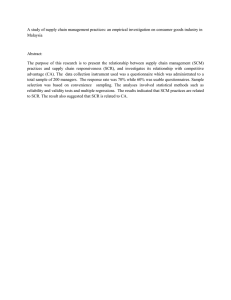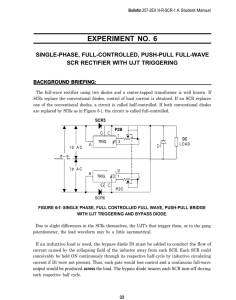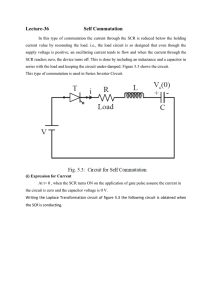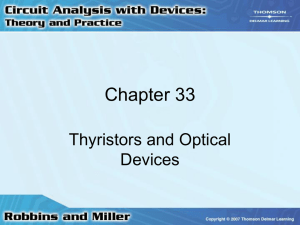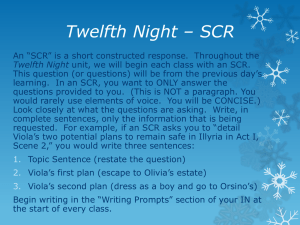Power Control Circuits
advertisement
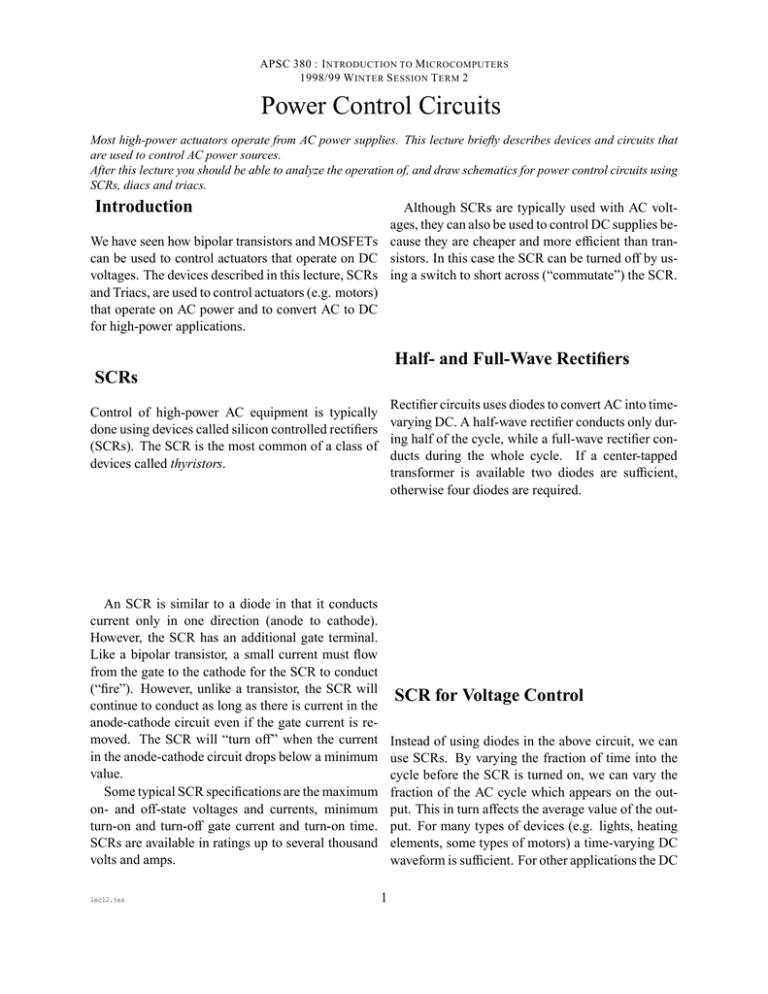
APSC 380 : I NTRODUCTION TO M ICROCOMPUTERS 1998/99 W INTER S ESSION T ERM 2 Power Control Circuits Most high-power actuators operate from AC power supplies. This lecture briefly describes devices and circuits that are used to control AC power sources. After this lecture you should be able to analyze the operation of, and draw schematics for power control circuits using SCRs, diacs and triacs. Introduction Although SCRs are typically used with AC voltages, they can also be used to control DC supplies beWe have seen how bipolar transistors and MOSFETs cause they are cheaper and more efficient than trancan be used to control actuators that operate on DC sistors. In this case the SCR can be turned off by usvoltages. The devices described in this lecture, SCRs ing a switch to short across (“commutate”) the SCR. and Triacs, are used to control actuators (e.g. motors) that operate on AC power and to convert AC to DC for high-power applications. Half- and Full-Wave Rectifiers SCRs Rectifier circuits uses diodes to convert AC into timeControl of high-power AC equipment is typically varying DC. A half-wave rectifier conducts only durdone using devices called silicon controlled rectifiers ing half of the cycle, while a full-wave rectifier con(SCRs). The SCR is the most common of a class of ducts during the whole cycle. If a center-tapped devices called thyristors. transformer is available two diodes are sufficient, otherwise four diodes are required. An SCR is similar to a diode in that it conducts current only in one direction (anode to cathode). However, the SCR has an additional gate terminal. Like a bipolar transistor, a small current must flow from the gate to the cathode for the SCR to conduct (“fire”). However, unlike a transistor, the SCR will continue to conduct as long as there is current in the anode-cathode circuit even if the gate current is removed. The SCR will “turn off” when the current in the anode-cathode circuit drops below a minimum value. Some typical SCR specifications are the maximum on- and off-state voltages and currents, minimum turn-on and turn-off gate current and turn-on time. SCRs are available in ratings up to several thousand volts and amps. lec12.tex SCR for Voltage Control Instead of using diodes in the above circuit, we can use SCRs. By varying the fraction of time into the cycle before the SCR is turned on, we can vary the fraction of the AC cycle which appears on the output. This in turn affects the average value of the output. For many types of devices (e.g. lights, heating elements, some types of motors) a time-varying DC waveform is sufficient. For other applications the DC 1 will have to be filtered. The solid-state relay works similarly to the optoisolator that was described earlier. The control side uses an LED to turn a light-operated SCR or transistor (for DC) or triac (for AC) on and off. These solid-state relays are available as encapsulated modules with guaranteed minimum isolation between the input and controlled terminals. In this case the SCRs will turn off by themselves when the gate current is turned off and the AC voltage reaches zero (twice per cycle). Triacs A triac is a device that behaves like two SCRs connected in parallel anode-to-cathode with one common gate. This arrangement allows current flow in both directions through the same device. By controlling the point in the waveform when the triac is turned on, it can also be used to control the average power delivered to the load. A triac is often used with another device called a diac which conducts current (in either direction) when the voltage across it exceeds a certain threshold. By using an RC circuit to vary the phase of the voltage applied to the diac, it is possible to control the turn-on time of the triac within the cycle. This is how common light dimmers work. Transistor Switching for Generating AC By using transistors to switch a DC supply on and off it is possible to create a square wave. If this square wave drives a current through the primary of a transformer then we can obtain a higher (or lower) AC voltage at the secondary by using a transformer with an appropriate turns ratio. This is how “power inverters” are used to drive AC-powered devices from batteries. We can also control the frequency of the AC waveform thus control the speeds of certain types of (“synchronous”) AC motors. Solid state Relays 3-phase circuits A “solid-state relay” is a circuit that has the same purpose as a magnetically-operated relay. It allows a low-power circuit to turn a high-power circuit on and off. The relay isolates the control circuit (usually lowvoltage electronics) from the controlled circuit (usually high-voltage power devices) and prevents voltages from being transferred to the control circuits and causing damage. While low-power loads (less than about 15 A at 120 VAC=1800kVA) can use the types of single-phase power control circuits described above, most highpower (e.g. more than 25 A at 240 VAC = 6 kVA) AC devices operate on 3-phase power. The principles and components required are the same but the control electronics must switch three phases instead of one. 2
